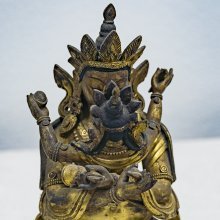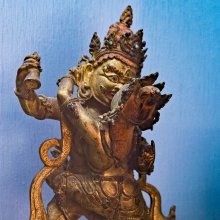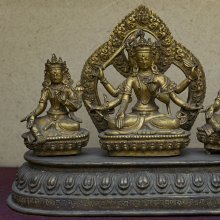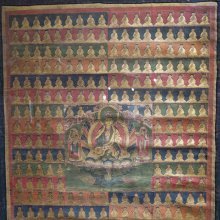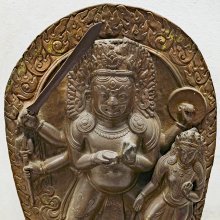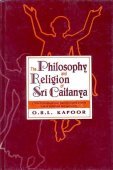Shakti, Śakti, Śaktī: 57 definitions
Introduction:
Shakti means something in Hinduism, Sanskrit, Jainism, Prakrit, the history of ancient India, Marathi, Hindi, Tamil. If you want to know the exact meaning, history, etymology or English translation of this term then check out the descriptions on this page. Add your comment or reference to a book if you want to contribute to this summary article.
The Sanskrit terms Śakti and Śaktī can be transliterated into English as Sakti or Shakti, using the IAST transliteration scheme (?).
Images (photo gallery)
(+51 more images available)
In Hinduism
Shilpashastra (iconography)
Source: Wisdom Library: Elements of Hindu IconograpyAt the end of an aeonic destruction, (saṃhāra) for the purpose of creating the śuddha-tattvas, the suddha-bhuvanas, and for the removal of dirt (mala) from Yogis, five Saktis evolve as follows:
when Śiva in his boundless mercy wills,
a thousandth part of his self emerges out of him as (1) Parāśakti;
from a thousandth part of this Parāśakti comes out (2) Ādiśakti,
a thousandth part of Ādi-śakti gives rise to (3) Icchāśakti;
from this latter are produced in a similar manner (4) Jñānaśakti and (5) Kṛyāśakti.
These five Śaktis are also known as
- Parāśakti (also known as Śāntyātītaśakti),
- Ādiśakti (also known as Śāntiśakti),
- Icchāśakti (also known as Vidyāśakti),
- Jñānaśakti (also known as Pratiṣṭhāśakti),
- Kṛyāśakti (also known as Nivṛttiśakti).
From the five Śaktis mentioned just now appear the five different Sadāśiva-tatvas.
- Śivasādākhya, from a tenth part of Parāśakti, (also known as Sadāśiva),
- Amūrttasādākhya, from a tenth part of Ādiśakti, (also known as Īśāna),
- Mūrttasādākhya, from a tenth part of Icchāśakti, (also known as Brahmā),
- Kartṛsādākhya , from a tenth part of Jñānaśakti, (also known as Īśvara),
- Karmasādākhya, from a tenth part of Kṛyāśakti, (also known as Īśāna);
Each one of these tatvas is dependent upon its immediate predecessor.
Source: Google Books: Elements of Hindu iconographyŚakti is the name applied to the spear. It consists of a metallic piece, either quadrangular or elliptical in shape, with a socket into which a long wooden handle is fixed.
Source: Red Zambala: Hindu Icons and Symbols | DeviLike Śiva, his Śakti is also extremely complex. The Śakti of Śiva is depicted under three main aspects:—
- a creative, active aspect called simply Śakti (“Energy”),
- an abiding, peaceful, spatial aspect named Pārvatī (“the daughter of the mountain”, i.e., Ether personified),
- and a destructive time aspect known as the Kālī (“power of time”).
When Śakti, which is also the Vimarśa (“power to think”), unites with the Lord of sleep (Svapneśvarī ?), a state of agitation, or unrest (unmana) arises, from which projection of the universe springs forth.
When Śakti separates herself and remains aloof from him, a state of perfect quiescence or harmonization occurs (samana), in which the world dissolves.
Source: Shodhganga: The significance of the mūla-beras (śilpa)Śakti (शक्ति) refers to the “spear” or “ornamental blade”, and represents one of the several “attributes” (āyudha) or “accessories” of a detiy commonly seen depicted in Hindu iconography, defined according to texts dealing with śilpa (arts and crafs), known as śilpaśāstras.—Śakti is the name applied to the spear. It consists of a metallic piece, either quadrangular or elliptical in shape, with a socket into which a long wooden handle is fixed.

Shilpashastra (शिल्पशास्त्र, śilpaśāstra) represents the ancient Indian science (shastra) of creative arts (shilpa) such as sculpture, iconography and painting. Closely related to Vastushastra (architecture), they often share the same literature.
Pancaratra (worship of Nārāyaṇa)
Source: archive.org: Isvara Samhita Vol 5Śakti (शक्ति) or Śaktimudrā is the name of a mudrā described in the Īśvarasaṃhitā 36-38.—Accordingly, “the fingers, in the left hand, lying on their back and remaining separately and stretched out, are to be bent down, so that the thumb could be like a bridge from the edge, could face in the fingers clinging to the middle. This shall be formed to face the heart and it is śaktimudrā offering pleasure. Understand this in the case of Śrī and other beginning from the forefinger to the little finger”.
Mūdra (eg., Śakti-mudrā) is so called as it gives joy to the tattvas in the form of karman for those who offer spotless worship, drive out the defects which move about within and without and sealing up of what is done.
Source: archive.org: Catalogue of Pancaratra Agama TextsŚakti (शक्ति, “energy”) refers to one of the Ṣāḍguṇya (“six ideal and immutable virtues”), as discussed in the second chapter of the Ahirbudhnyasaṃhitā, a Pāñcarātra work in 60 chapters dealing with topics such as Viṣṇu’s discus-power, the processes of creation and esoteric practices related to Sudarśana (such as mantras and yantras).—[Cf. the chapter ṣaḍguṇya-brahmaviveka]: [...] The six ideal and immutable virtues (ṣāḍguṇya) which characterise the Eternal Being (parabrahman) are: jñāna—Intellect, śakti—Energy, aiśvarya—Sovereignty, bala—Inexhaustibility, vīrya—Immutability and tejas—self-sufficiency. The latter five of which are comprehended in the first. When these are concentrated, it is the Eternal Being in His essence; when the five radiate out of the one, then it is Sudarśana in his own visible aspect (54-62).
Source: SriMatham: Vaiṣṇava Iconology based on Pañcarātra ĀgamaŚakti (Energy) this is the potency or the ability to become the material cause of the universe as well as the efficient cause. This guṇa is also defined as the "accomplishing of the non accomplished" i.e. the ability to produce something, the cause of which can not be accounted for by empirical methods.

Pancaratra (पाञ्चरात्र, pāñcarātra) represents a tradition of Hinduism where Narayana is revered and worshipped. Closeley related to Vaishnavism, the Pancaratra literature includes various Agamas and tantras incorporating many Vaishnava philosophies.
Purana and Itihasa (epic history)
Source: Google Books: Cultural History from the Vāyu PurānaŚakti (शक्ति, “Spear”):—The word śakti meaning ‘spear’ is found in the Ṛgveda. Kauṭilya defines it as a weapon provided with edges like a ploughshare. In the Mahābhārata ‘śakti’ means a spear or a javelin particularly used as an adjunct to the bow by the warrior in the chariot. There it does not essentially belong to the knight’s furnishings. The Vāyu-purāṇa associates śakti only with Kārtikeya.
Source: archive.org: Puranic Encyclopedia1) Śakti (शक्ति).—General. Son of Vasiṣṭha by Arundhatī. He was the first-born among the hundred sons of Vasiṣṭha. Kalmāṣapāda, the Rākṣasa captured and ate Śakti and his pregnant wife Adṛśyantī spent her days in great grief with Vasiṣṭha. Parāśaramuni, father of Vyāsa, was Adṛśyantī’s son. (For details see under (Adṛśyantī). Other information
(i) It was Śiva, who incarnated himself as the son of Vasiṣṭha.
(ii) Gopāyana, Bharadvāja, Āpastamba and Arṇodara belong to the line of disciples of Śakti. (Vāmana Purāṇa, Chapter 6). (See full article at Story of Śakti from the Puranic encyclopaedia by Vettam Mani)
2) Śakti (शक्ति).—The weapon of Subrahmaṇya is called Śakti, and it was made by Viśvakarman. Viśvakarman once grilled Sūrya (sun) on his machine and reduced his glow. The glow thus released by Viśvakarman fell on the earth and Viśvakarman made with that glow the cakra (disc) of Viṣṇu, the triśūla (trident) of Siva the Puṣpaka, aerial chariot of Kubera and the Śakti of Subrahmaṇya. (Viṣṇu Purāṇa, Part 3, Chapter 2).
3) Śakti (शक्ति).—The sound 'Ś' means welfare or prosperity and 'kti' prowess. Therefore Śakti means she, who is the embodiment of prosperity and prowess or she, who grants prosperity and prowess. The definition of 'Bhagavatī' is, she who combines in herself knowledge affluence, wealth, reputation, power and the female organ. Therefore the word 'Śakti' may be taken to mean Bhagavatī and Pārvatī, and what are termed as Bhagavatī, Śakti, Devī, Ambikā, Pārvatī etc. are the manifestations of Śakti, Śiva’s spouse. This Śakti exists fractionally in all Devas. When, once upon a time the devāsura war broke out the Śaktis of Devas like Brahmā emerged to help Caṇḍikā. The vehicle, ornaments, weapon etc. of each Deva, his Devī also possessed. The Śaktis (Devīs) of the Devas appeared in the following manner. Brahmāṇī, wife of Brahmā, rode on the swan wearing beads around her neck and holding the water-vessel in her hands. She was followed by Vaiṣṇavī Viṣṇu’s Śakti on Garuḍa wearing yellow clothes and with the conch, disc, lotus etc. in her hands. Śāṅkarī Śiva’s Śakti rode on the ox with the crescent moon and serpents as ornaments and holding in her hands the Śūla. 'Kaumārī', Subrahmaṇya’s Śakti rode on Airāvata with śūla in hands. The Śakti called 'Vārāhī in the form of a great boar rode carrying a corpse, Nārasiṃhī' Śakti took the form of narasiṃha (half man and half lion). Yāmyā, Yama’s śakti, rode on buffalo holding in her hands a long stick. Śaktis called Kauberī and Vāruṇī took their respective forms and in this manner all the Śaktis came to the help of Devī. This sight pleased not only the Devas, but the mother of the universe also. Along with them incarnated on earth Śaṃkara, who gives 'śaṃ' (happiness) to the world and blessed Caṇḍikā on the battle-field (Devī Bhāgavata, 5th and 9th Skandhas).
Source: archive.org: Shiva Purana - English Translation1) Śakti (शक्ति) refers to the “Goddess of all and the prime cause and the mother of the three deities”, and is explained as being created from the body of Īśvara, according to Śivapurāṇa 2.1.6, while explaining the time of great dissolution (mahāpralaya):—“[...] the original Being without a second, with neither beginning nor end, that illuminates everything, that is in the form of Cit (pure knowledge), that which is termed Supreme Brahman, the all-pervasive and undecaying, vanished, The manifest form of the formless Being is Sadāśiva. Scholars of the ancient and succeeding ages have sung of it as Īśvara. Īśvara though alone, then created the physical form Śakti from his body. This Śakti did not affect his body in any way”.
This Śakti is called by various names. Pradhāna, Prakṛti, Māyā, Guṇavatī, Parā. The mother of Buddhi Tattva (The cosmic Intelligence), Vikṛtivarjitā (without modification). That Śakti is Ambikā, Prakṛti and the goddess of all. She is the prime cause and the mother of the three deities She has eight arms. Her face wears a peculiar splendour, the splendour of a thousand moons. Thousands of stars perpetually sparkle round her face She is bedecked in various ornaments. She has various weapons. She is capable of various movements. Her eyes beam like a full blown lotus. She has a brilliance which could hardly be conceived. She is the generating cause of all. She sprang up singly as Māyā. In her union she manifested in various forms.
2) Śakti (शक्ति) (i.e., the son of Vasiṣṭha and Arundhatī) is the name of an ancient Sage (Muni), according to the Śivapurāṇa 2.3.39 (“The gods arrive at Kailāsa”).
3) Śakti (शक्ति) refers to “spears (used as a weapon in battle), according to the Śivapurāṇa 2.5.15 (“The birth of Jalandhara and his marriage”).
Source: Cologne Digital Sanskrit Dictionaries: The Purana Index1a) Śakti (शक्ति).—(Śaktri, Brahmāṇḍa-purāṇa) the eldest of the 100 sons of Vasiṣṭha and Arundhatī. Father of Parāśara through Adṛśyanti;1 a sage by tapas; a Vedavyāsa. Heard the vāyu purāṇa from Dakṣa and narrated it to Parāśara in embryo;2 a resident of Brahmakṣetra;3 cursed king Kalmāṣapāda in Naimiṣa.4
- 1) Bhāgavata-purāṇa IV. 1. 41; Brahmāṇḍa-purāṇa I. 1. 9; III. 8. 91; 36. 6; Matsya-purāṇa 201. 30; Vāyu-purāṇa 1. 174; 70. 83.
- 2) Brahmāṇḍa-purāṇa II. 32; 99 and 115; 35. 124; IV. 4. 65; Matsya-purāṇa 196. 26; Vāyu-purāṇa 103. 65.
- 3) Vāyu-purāṇa 59. 91, 105.
- 4) Ib. 2. 10-11.
1b) The principle identified with Śiva;1 urges creation by Brahmā.2
1c) As a daughter of Vasiṣṭha and Arundhatī.*
- * Brahmāṇḍa-purāṇa I. 2. 10.
1d) (Parāśakti): the Goddess as potency in all creatures; by worshipping her in any manner one gets salvation;1 by worshipping her Śiva became Ardhanārīśvara; as also other Gods like Brahmā; known as Tripurā;2 mind-born daughter of Brahmā by name Prakṛti; was born during the course of the churning of the ocean; known also as Bhagavatī and Māyā; angry at not getting a share in the yajña of Yuvanāśva but appeased by Brahmā that she may be propitiated with paśu offerings.3 A number of Śaktis mounted on cuckoos, swans, mungooses followed Lalitā's army.4
1e) The tula or balance of scale, addressed as.*
- * Matsya-purāṇa 274. 59.
1f) The name of Vyāsa in the 25th (27th, Viṣṇu-purāṇa) Dvāpara; Muṇḍīśvara avatār of the lord.*
- * Vāyu-purāṇa 23. 208; Viṣṇu-purāṇa III. 3. 18.
1g) A resident of Brahmakṣetra.*
- * Vāyu-purāṇa 59. 105.
1h) An Ajitadeva.*
- * Vāyu-purāṇa 67. 34.
1i) The wife of Gods generally.*
- * Vāyu-purāṇa 106. 59.
1j) Of Viṣṇu; is Pradhāna puruṣātmaka; this energy separates at the deluge and unites at the time of creation;1 something like fire in wood or oil in sesamum; from Pradhāna germinate intellect and rudiments of things and from them Asuras;2 Pradhāna compared to a tree; Viṣṇu is mūla-prakṛti or the primary nature in whom all beings exist and all finally immerse;3 is three-fold made up of the three energies of Hari.4
1k) Of Guha, created by Viśvakarma from the Vaiṣṇava effulgence of Sūrya.*
- * Viṣṇu-purāṇa III. 2-12.
Śakti (शक्ति) was born to Vasiṣṭha and Arundhatī, according to one account of Vaṃśa (‘genealogical description’) of the 10th century Saurapurāṇa: one of the various Upapurāṇas depicting Śaivism.—Accordingly, Nārada gave a daughter to Vasiṣṭha. She was Arundhati and Śakti was born to her. Śakti begot Parāśara and from Parāśara was born Kṛṣṇa Dvaipāyana.

The Purana (पुराण, purāṇas) refers to Sanskrit literature preserving ancient India’s vast cultural history, including historical legends, religious ceremonies, various arts and sciences. The eighteen mahapuranas total over 400,000 shlokas (metrical couplets) and date to at least several centuries BCE.
Shaivism (Shaiva philosophy)
Source: Wisdom Library: Kubjikāmata-tantra1) Śaktī (शक्ती):—One of the nine Dūtī presided over by one of the nine bhaivaravas named Ananta (emanation of Ananta himself, who is the central presiding deity of Dūtīcakra), according to the Kubjikāmata-tantra and the Ṣaṭsāhasrasaṃhitā.
2) Śaktī (शक्ती):—One of the nine Dūtī presided over by one of the nine bhaivaravas named Mudreśa (emanation of Ananta, who is the central presiding deity of Dūtīcakra), according to the Kubjikāmata-tantra and the Ṣaṭsāhasrasaṃhitā.
Source: Google Books: Manthanabhairavatantram (shaivism)Śakti (शक्ति) refers to a “javelin” and represents one of the attributes of Svacchanda, according to the Śrīmatottara-tantra, an expansion of the Kubjikāmatatantra: the earliest popular and most authoritative Tantra of the Kubjikā cult. Accordingly, “O goddess, Svacchanda is in the middle, within the abode of the triangle. Very powerful, he has five faces with three times five flaming eyes. [...] O fair lady, my attributes—trident, dagger, sword, the king of the snakes, and rosary—adorn the right (arms). O beloved, a skull, double-headed drum, javelin [i.e., śakti], noose and goad—(these) are my divine, brilliant and very auspicious weapons that (are held) in the left (hands). The king of snakes (hangs) on the shoulder and a garland of skulls hangs (from the neck). There is a necklace of scorpions around the throat and the ears are adorned with snakes. [...]”.
Source: Shodhganga: Iconographical representations of ŚivaŚakti (शक्ति).—For the benefit of the world Śiva conceives a spontaneous idea, which results in the manifestation of śakti from his one-thousandth part. Then comes Parā-śakti, Ādi-śakti, Icchā-śakti and Kriyā-śakti, each succeeding from the 1/1000 part of the preceeding one. All these śaktis are niṣkala. This is Śivasṛṣṭi.
Source: Shodhganga: The significance of the mūla-beras (shaivism)Śakti (शक्ति) or Śivakāmi refers to the wife of Śiva. The primal energy is called puruṣa or Śiva and the prakṛti or nature is called Śakti. Thus, it is believed that the creation of the universe takes place when Śiva and Śakti unite.
Source: Shodhganga: Temple management in the ĀgamasŚakti (शक्ति) refers to one of the various Devatā weapons and represents a type of “temple implement (instrument)” as described in the Karaṇalakṣaṇavidhi-paṭala section of the Uttara-Kāmikāgama.—The instruments should be according to the particular śāstra followed at the temple. Some of the instruments mentioned are weapons of all Devatās including [viz., śakti].
Source: Himalayan Academy: Dancing with SivaŚākta means “relating to Śāktism”, which refers to the “doctrine of power”.—The religion followed by those who worship the Supreme as the Divine Mother—Śakti or Devī—in Her many forms, both gentle and fierce. Śāktism is one of the four primary sects of Hinduism. Śāktism’s first historical signs are thousands of female statuettes dated ca 5500 BCE recovered at the Mehrgarh village in India. In philosophy and practice, Śāktism greatly resembles Śaivism, both faiths promulgating, for example, the same ultimate goals of advaitic union with Śiva and mokṣa. But Śāktas worship Śakti as the Supreme Being exclusively, as the dynamic aspect of Divinity, while Śiva is considered solely transcendent and is not worshiped.

Shaiva (शैव, śaiva) or Shaivism (śaivism) represents a tradition of Hinduism worshiping Shiva as the supreme being. Closely related to Shaktism, Shaiva literature includes a range of scriptures, including Tantras, while the root of this tradition may be traced back to the ancient Vedas.
Dharmashastra (religious law)
Source: Wisdom Library: Dharma-śāstraŚakti (शक्ति) is a Sanskrit technical term, used in warfare, referring to the “strength” (of the king). It is supposed to be of threefold:
- prabhu (power, control),
- mantra (counsel),
- utsāha (energy).
The word is used throughout Dharmaśāstra literature such as the Manusmṛti. (See the Nītiprakāśikā 8.86)

Dharmashastra (धर्मशास्त्र, dharmaśāstra) contains the instructions (shastra) regarding religious conduct of livelihood (dharma), ceremonies, jurisprudence (study of law) and more. It is categorized as smriti, an important and authoritative selection of books dealing with the Hindu lifestyle.
Natyashastra (theatrics and dramaturgy)
Source: Wisdom Library: Nāṭya-śāstra1) Śakti (शक्ति, “placation”) refers to ‘powerful placation’ of one who is angry. Śakti represents one of the thirteen vimarśasandhi, according to the Nāṭyaśāstra chapter 21. Vimarśasandhi refers to the “segments (sandhi) of the pause part (vimarśa)” and represents one of the five segments of the plot (itivṛtta or vastu) of a dramatic composition (nāṭaka).
2) Śakti (शक्ति, “placation”) refers to a “spear”, a weapon which should measure should measure eight tālas (unit of measurement), according to Nāṭyaśāstra chapter 23. In dramatic plays, weapons such as śakti should be made by experts using proper measurements and given to persons engaged in a fight, angry conflict or siege. It forms a component of āhāryābhinaya (extraneous representation).
Source: archive.org: Natya ShastraŚakti (शक्ति).—One of the thirteen elements of the ‘pause segment’ (vimarśasandhi);—(Description:) Coming into conflict [with anyone] is called Strength (śakti).

Natyashastra (नाट्यशास्त्र, nāṭyaśāstra) refers to both the ancient Indian tradition (shastra) of performing arts, (natya—theatrics, drama, dance, music), as well as the name of a Sanskrit work dealing with these subjects. It also teaches the rules for composing Dramatic plays (nataka), construction and performance of Theater, and Poetic works (kavya).
Vastushastra (architecture)
Source: Wisdom Library: Vāstu-śāstraŚakti (शक्ति, “power”) refers to the third of nine aṃśa (part), according to the Mānasāra. Aṃśa is the alternative sixth of the āyādiṣaḍvarga, or “six principles” that constitute the “horoscope” of an architectural or iconographic object. Their application is intended to “verify” the measurements of the architectural and iconographic object against the dictates of astrology that lay out the conditions of auspiciousness.
The particular aṃśa (e.g., śakti) of all architectural and iconographic objects (settlement, building, image) must be calculated and ascertained. This process is based on the principle of the remainder. An arithmetical formula to be used in each case is stipulated, which engages one of the basic dimensions of the object (breadth, length, or perimeter/circumference). Among the nine taskara, the ones named ṣaṇḍa and vipat are inauspicious, and should therefore be avoided.

Vastushastra (वास्तुशास्त्र, vāstuśāstra) refers to the ancient Indian science (shastra) of architecture (vastu), dealing with topics such architecture, sculpture, town-building, fort building and various other constructions. Vastu also deals with the philosophy of the architectural relation with the cosmic universe.
Shaktism (Shakta philosophy)
Source: Google Books: Manthanabhairavatantram1) Śakti (शक्ति, “power”) refers to the Goddess, according to the Śrīmatottara-tantra, an expansion of the Kubjikāmatatantra: the earliest popular and most authoritative Tantra of the Kubjikā cult.—Accordingly, as the God Bhairava said to the Goddess: “You are Power (śakti) and I am the individual soul called the vital breath (prāṇa) of living beings (prāṇin). The individual soul consists of Fire (i.e. power) and Air (breath) and is established in the Body of Kula [i.e., kulapiṇḍa]”.
2) Śakti (शक्ति, “power”) refers to one of the seventeen stages of the rise of kuṇḍalinī, according to Abhinavagupta as drawn from the Devyāyāmala.—Cf. The seventeen syllables [i.e., saptadaśākṣara] of Mantramātā.—[...] These seventeen units [are] to be arranged in as many locations along the axis of the subtle body, [as was] clearly known to Abhinava. Thus he presents an ascending series marking the stages of the rise of Kuṇḍalinī, the highest stage of which is that of the ‘Pure Self’ heralded by the Transmental just below it. In this set-up, drawn by Abhinavagupta from the Devyāyāmala, there are seventeen stages. These are [e.g., the Power (śakti), ...].
Jayaratha quotes this [Devyāyāmala] Tantra as a source of [Kālasaṃkarṣiṇī’s] Vidyā consisting of seventeen syllables. As the Devyāyāmala tells us that these places are related to the recitation of mantra, we may conclude that the seventeen syllables are contemplated in these seventeen places [e.g., Power (śakti)]. Accordingly, the Wheel of the Self can be said to be at the end of (i.e. after) the sixteen [i.e., ṣoḍaśānta].
3) Śakti (शक्ति) is associated with Mahākāla: one of the nine Bhairava associated with the nine energies of Navātman, according to the Manthānabhairavatantra, a vast sprawling work that belongs to a corpus of Tantric texts concerned with the worship of the goddess Kubjikā.—[Note: this passage is drawn from the Gurukramasūtra]—Another way in which the nine energies of Navātman may be understood are as nine aspects of the Command that generates the Bhairavas corresponding to its nine letters. [...] In this case Navātman is SHKṢMLVRYŪ(Ṃ): [...] Mahākāla (Ma) is born of Energy (śakti). [...] (This) is the excellent teacher within the tradition. He who knows the teacher here is the delight of Kula.
Source: DSpace at Pondicherry: Siddha Cult in Tamilnadu (shaktism)Śakti (शक्ति).—According to the traditional Śākta-Tāntric viewpoint, Śakti is inherent in Śiva as the power of burning is in fire. The supposed five faces of Śiva–Īśāna, Tatpurusa, Sadyojāta, Vāmadēva and Aghora-symbolise the functioning of Śakti in the spheres of consciousness (cit), bliss (ānanda), will (icchā), knowledge (jñana), and action (kriyā) respectively.
Śakti is the important goddess of Tantra. She is responsible for creation, expansion and destruction of the universe. Puruṣa is of secondary importance, though the Śakti cannot accomplish the work of creation of the universe without Puruṣa. This is why in Śaktism, Śakti is the main deity and the Puruṣa a subordinate one.
Source: Brill: Śaivism and the Tantric Traditions (shaktism)Śakti (शक्ति) refers to a set of the fourteen goddesses/powers, according to the Kāmasiddhi-stuti (also Vāmakeśvarī-stuti) and the Vāmakeśvaratantra (also known as Nityāṣoḍaśikārṇava).—[...] The next four verses, 17–20 [of the Kāmasiddhistuti], respectively praise the set of fourteen goddesses/powers (śaktis). We know only the name of the first from this text but the rest can be known from the Vāmakeśvaratantra (1.165–168).
The fourteen Śaktis (goddesses/powers) are:
- Sarvasaṃkṣobhaṇī,
- Sarvavidrāviṇī,
- Sarvākarṣiṇī,
- Sarvāhlādinī,
- Sarvasaṃmohinī,
- Sarvastambhanī,
- Sarvajambhanī,
- Sarvatovaśinī,
- Sarvarañjanī,
- Sarvonaccompamādinī,
- Sarvārthasādhanī,
- Sarvasampattipūraṇī,
- Sarvamantramayī and
- Sarvadvandvakṣayaṃkarī.

Shakta (शाक्त, śākta) or Shaktism (śāktism) represents a tradition of Hinduism where the Goddess (Devi) is revered and worshipped. Shakta literature includes a range of scriptures, including various Agamas and Tantras, although its roots may be traced back to the Vedas.
Vyakarana (Sanskrit grammar)
Source: Shodhganga: Vaiyākaraṇabhūṣaṇasāra: a critical studyŚakti (शक्ति).—Faculty of import or denotation which is possessed by the words permanently according to Kauṇḍa Bhaṭṭa.
Source: Wikisource: A dictionary of Sanskrit grammarŚakti (शक्ति).—Potentiality of expressing the sense which is possessed by words permanently with them ;denotative potentiality or denotation; this potentiality shows the senses, which are permanently possessed by the words, to the hearer and is described to be of one kind by ancient grammarian as contrasted with the two (अभिघा (abhighā) and लक्षणा (lakṣaṇā)) mentioned by the modern ones. It is described to be of two kinds-(a) स्मारिका शक्ति (smārikā śakti) or recalling capacity which combines चैत्रत्व (caitratva) with पाक (pāka), and अनुभावि-का शक्ति (anubhāvi-kā śakti) which is responsible for the actual meaning of a sentence. For details see Vakyapadiya III.

Vyakarana (व्याकरण, vyākaraṇa) refers to Sanskrit grammar and represents one of the six additional sciences (vedanga) to be studied along with the Vedas. Vyakarana concerns itself with the rules of Sanskrit grammar and linguistic analysis in order to establish the correct context of words and sentences.
Kavyashastra (science of poetry)
Source: Shodhganga: The Kavyavilasa of Ciranjiva Bhattacarya (kavyashastra)Śakti (शक्ति) refers to “inborn intuitive intellectual power” according to Ācārya Rudraṭa.—He is of opinion that śakti, vyutpatti (an accomplishment in the knowledge of scriptures and literary works) and abhyāsa (constant practice) are the causal factors of poetry (kāvya). Mammaṭa, the author of Kāvyaprakāśa, has said that pratibhā which he terms as śakti is the kavitvabīja or the basic element of poetry.

Kavyashastra (काव्यशास्त्र, kāvyaśāstra) refers to the ancient Indian tradition of poetry (kavya). Canonical literature (shastra) of the includes encyclopedic manuals dealing with prosody, rhetoric and various other guidelines serving to teach the poet how to compose literature.
Vaishnavism (Vaishava dharma)
Source: Pure Bhakti: Bhagavad-gita (4th edition)Śakti (शक्ति) refers to “potency, or energy”. (cf. Glossary page from Śrīmad-Bhagavad-Gītā).
Source: Pure Bhakti: Brhad BhagavatamrtamŚakti (शक्ति) refers to:—Power; energy; potency. (cf. Glossary page from Śrī Bṛhad-bhāgavatāmṛta).

Vaishnava (वैष्णव, vaiṣṇava) or vaishnavism (vaiṣṇavism) represents a tradition of Hinduism worshipping Vishnu as the supreme Lord. Similar to the Shaktism and Shaivism traditions, Vaishnavism also developed as an individual movement, famous for its exposition of the dashavatara (‘ten avatars of Vishnu’).
Nirukta (Sanskrit etymology)
Source: Shodhganga: The saurapurana - a critical study (nirukta)Śakti (शक्ति) is derived from the root sak meaning “to be strong or powerful, be able to or capable of or competent for” etc. Accordingly Śakti variously signifies power, ability, faculty strength, energy prowess, regal power or signification of a word or term; the power inherent in cause to produce its necessary effect; an iron spear, lance, pike, dart, a sword. Śakti is the female organ; Śakti is the active power of a deity and regarded mythologically as Śiva’s goddess—consort and queen.
Nirukta (निरुक्त) or “etymology” refers to the linguistic analysis of the Sanskrit language. This branch studies the interpretation of common and ancient words and explains them in their proper context. Nirukta is one of the six additional sciences (vedanga) to be studied along with the Vedas.
Yoga (school of philosophy)
Source: ORA: Amanaska (king of all yogas): A Critical Edition and Annotated Translation by Jason BirchŚakti (शक्ति) refers to “Kuṇḍalinī”, according to the Haṭhapradīpikā of Svātmārāma: an influential 15th-century Sanskrit manual on Hatha-Yoga dealing with techniques to channel one’s vital energy.—Accordingly, “For the Yogin whose awakening of Kuṇḍalinī [i.e., śakti-bodha] has occurred and whose actions have been completely renounced, the natural [state of Samādhi] arises spontaneously”.

Yoga is originally considered a branch of Hindu philosophy (astika), but both ancient and modern Yoga combine the physical, mental and spiritual. Yoga teaches various physical techniques also known as āsanas (postures), used for various purposes (eg., meditation, contemplation, relaxation).
Arthashastra (politics and welfare)
Source: ORA: Amanaska (king of all yogas): (artha)Śakti (शक्ति) refers to the Three Powers (required by a king in order to rule successfully), according to the Arthaśāstra (verse 6.2.33).—In the Amanaska Yoga (verse 2.87), the Yogin is being compared to a king whose foot soldiers are the Yogin’s quelled senses and whose Śakti is the Yogin’s higher faculty of discernment (buddhi). [...]
According to the Nītiśāstra, the three powers (śakti) (required by a king in order to rule successfully) are:
- power of personal leadership (prabhu-śakti),
- good counsel (mantra-śakti) and
- vigour (utsāha-śakti).
In his Arthaśāstra (6.2.33), Kauṭilīya defines the three as follows: “A [good king’s] powers (śakti) are threefold; mantraśakti is the strength of his wisdom, prabhuśakti is the strength of his treasury and army, and utsāhaśakti is the strength of his valour”.

Arthashastra (अर्थशास्त्र, arthaśāstra) literature concerns itself with the teachings (shastra) of economic prosperity (artha) statecraft, politics and military tactics. The term arthashastra refers to both the name of these scientific teachings, as well as the name of a Sanskrit work included in such literature. This book was written (3rd century BCE) by by Kautilya, who flourished in the 4th century BCE.
Sports, Arts and Entertainment (wordly enjoyments)
Source: archive.org: Syainika Sastra of Rudradeva with English Translation (art)Śakti (शक्ति) refers to “darts” (used during hunting), according to the Śyainika-śāstra: a Sanskrit treatise dealing with the divisions and benefits of Hunting and Hawking, written by Rājā Rudradeva (or Candradeva) in possibly the 13th century.—Accordingly, “Hunting on horseback (āśvina) represents one of the eight subdivisions of Hunting (mṛgayā). [...] But something should be said in brief about hunting, for the diffusion of its knowledge. [...] Five or six horsemen are quite enough for hunting rhinoceros. The horses should be quiet and well-trained in their motion. A horseman should strike the rhinoceros with small darts (kṣudra-śakti) in quick succession on the back. [...]”.

This section covers the skills and profiencies of the Kalas (“performing arts”) and Shastras (“sciences”) involving ancient Indian traditions of sports, games, arts, entertainment, love-making and other means of wordly enjoyments. Traditionally these topics were dealt with in Sanskrit treatises explaing the philosophy and the justification of enjoying the pleasures of the senses.
Shaiva philosophy
Source: archive.org: Chittanubodha Shastram By Bhaskara KanthaŚakti (शक्ति) refers to the “dynamic energies” (of Śiva).—The Kashmir Śaiva thinkers believe in pluralism because not all human beings are alike and the different paths and Philosophies are meant for different kinds of people. [...] The dynamism of the world flows from the very heart of vibrative Consciousness or spanda. This is also related to the conception of Śiva’s Śaktis or dynamic Energies. The Śaktis are not separate from Śiva, hence there is complete advaita or non-duality, but they manifest his creative activity flowing out, as well as the cognitive activity flowing back to the source (icchā, jñāna and kriyā-śaktis). The Śaktis have the power both to conceal and to reveal the Supreme Reality. Śiva himself is absolute Freedom (svātantrya), and if he creates, he creates out of this freedom and overflowing bliss.
-
General definition (in Hinduism)
Source: Google Books: Tantra, Its Mystic and Scientific BasisThe great commentator of Śāradā Tilaka, Rāghava Bhaṭṭa, says that like the Saṃkhya concept of appearance of realities from realities (Sadutapattivāda), Śakti which remains in the dormant stage in Parā-Saṃvit becomes manifest (Ucchunāvasthā). Śakti is without any cause. She is beginningless. Here Caitanyadhyasena means the eternal coexistence of Śiva and Śakti. The eternal flow of Śakti is there but they are flowing without any feeling. Thus, Nirguṇa Śiva does not mean Śiva without Guṇa (Śakti) but it means the Guṇātīta state of Śiva. This Śakti-Tattva issues from Śiva-Tattva. It is further said that from Śakti evolves Nāda and from Nāda issues Bindu. From the causal Bindu proceeds the effect (kārya) Bindu, Nāda and Bīja.
Source: archive.org: A History of Indian PhilosophyAccording to the Vatula-tantra, Śakti is the will of God and that is called bindu. From that arises nāda which is a source of all speech.
Source: Apam Napat: Indian Mythology1) The cosmic female force is known as Shakti. She is the wife of Shiva and a form of Parvati.
2) Shakti was the eldest of the hundred sons of sage Vasishta and Arundhati. He married a woman named Adrishyanti, through whom he had a son named Parasara.
Source: WikiPedia: HinduismShakti, meaning “Power” or “empowerment,” is the primordial cosmic energy and represents the dynamic forces that are thought to move through the entire universe in Hinduism. Shakti is the concept, or personification, of divine feminine creative power, sometimes referred to as ‘The Great Divine Mother’ in Hinduism. On the earthly plane, shakti most actively manifests through female embodiment and creativity/fertility, though it is also present in males in its potential, unmanifest form.
Source: Red Zambala: On the Salvific Activities of GodThere are various lists given in the Purāṇas of the consorts of Lord Vishnu such as the 8 or the 12 Śaktis.
The 12 are:
- Lakṣmī — fortune,
- Puṣṭī — prosperity,
- Dayā — compassion,
- Nidrā —sleep,
- Kṣamā — forgiveness,
- Kāntī — beauty,
- Sarasvatī — Communication & learning,
- Dhṛti— endurance,
- Maitrī — loving kindness, friendliness,
- Ratī — Sexual pleasure,
- Tuṣṭī —satisfaction,
- Mati — intelligence.
In Jainism
General definition (in Jainism)
Source: archive.org: TrisastisalakapurusacaritraŚakti (शक्ति) refers to the science of “regal power”, according to chapter 2.2 [ajitanātha-caritra] of Hemacandra’s 11th century Triṣaṣṭiśalākāpuruṣacaritra: an ancient Sanskrit epic poem narrating the history and legends of sixty-three illustrious persons in Jainism.—Śakti has 3 divisions: prabhutva, excellence of treasure and army; mantra, good counsel; utsaha, energy.—(cf. Abhidhānacintāmaṇi 3.399)
Accordingly: “Sagara defeated his opponents by unerring quotations from the doctrine of Syādvāda, like Jitaśatru his enemies by arrows. He plunged into the unfathomable ocean of political science which had evil sea-monsters, filled with waves of the application of the six policies, of the (four) means, of regal power (i.e., śakti), etc. He learned without difficulty the eight-fold Ayurveda also, the torch of knowledge of the strength and effects of all herbs and essences. [...]”.

Jainism is an Indian religion of Dharma whose doctrine revolves around harmlessness (ahimsa) towards every living being. The two major branches (Digambara and Svetambara) of Jainism stimulate self-control (or, shramana, ‘self-reliance’) and spiritual development through a path of peace for the soul to progess to the ultimate goal.
India history and geography
Source: archive.org: Epigraphia Indica Vol. 1 (1892)Śakti (शक्ति) is the name of a Brāhman mentioned in the Pallava grant of king Śivaskandavarman. He is als known as Satti. The Prākrit Pallava king Śivaskandavarman of Kāñcī, who was affiliated to the Brahmanical gotra of the Bhāradvājas, confirmed and enlarged, in the eighth year of his reign, a donation, made formerly by the great king, the lord Bappa (i.e., probably his father), to certain Brahmans (e.g., Śakti), who resided at Āpiṭṭi or Āpiṭṭī, and were bhojakas, i.e., probably freeholders of the vilalge Chillarekakoḍuṃka or Chillerekakoḍuṃka.
According to the 4th century Pallava grant, “... and we grant here an immunity (viz.) the garden in Chillarekakoḍuṃka, which was formerly given by the great king, the lord Bappa, a giver of many krors of gold and of one hundred thousand ox-ploughs,—while he made (the gift) a means of the increase of the merit, longevity, power and fame of (his) own family and race —to the Brāhmans, freeholders of Chillarekakoḍuṃka (and) inhabitants of Āpiṭṭi, (viz.) ... to the four brothers Kumāranaṃdi/Kumāranandi (Kumāranandin), Kumārasama (Kumāraśarman), Koṭṭasama (Koṭṭaśarman) and Satti (Śakti) of the Kosika (Kauśika) gotra four shares of the produce ...”
Source: Cologne Digital Sanskrit Dictionaries: Indian Epigraphical GlossaryŚakti.—(EI 17), name of the wife of Kāmadeva. Note: śakti is defined in the “Indian epigraphical glossary” as it can be found on ancient inscriptions commonly written in Sanskrit, Prakrit or Dravidian languages.
--- OR ---
Śakti.—(IE 7-1-2; EI 25), ‘three’; three in number (EI 6). Note: śakti is defined in the “Indian epigraphical glossary” as it can be found on ancient inscriptions commonly written in Sanskrit, Prakrit or Dravidian languages.

The history of India traces the identification of countries, villages, towns and other regions of India, as well as mythology, zoology, royal dynasties, rulers, tribes, local festivities and traditions and regional languages. Ancient India enjoyed religious freedom and encourages the path of Dharma, a concept common to Buddhism, Hinduism, and Jainism.
Languages of India and abroad
Marathi-English dictionary
Source: DDSA: The Molesworth Marathi and English Dictionaryśakti (शक्ति).—f (S) Ability or capability: also strength, might, power. Ex. of comp. śarīraśakti, indriyaśakti, nētraśakti, karṇaśakti, vāyuśakti, jñānaśakti, yōgaśakti, kālaśakti. 2 Power (as of a word); reach or extent of significance. 3 The energy or active power of a deity personified as his wife; as Parvati and Lakshmi of Shiva and Vishn̤u. 4 The female organ as the counterpart of the phallic personification of Shiva, and worshiped by a sect of Hindus thence termed Shakt. 5 An iron spear or dart.
--- OR ---
sakti (सक्ति).—f S Attachment or junction, contact, conjunction, cohesion. 2 fig. Intentness upon; earnestness of application unto.
--- OR ---
saktī (सक्ती).—f ( P) Hardness, firmness, solidity. 2 fig. Harshness, sternness, austerity, severity, cruelty: also rigor or rigorousness, grievousness &c. Used freely.
Source: DDSA: The Aryabhusan school dictionary, Marathi-Englishśakti (शक्ति).—f Ability; power. An iron spear.
--- OR ---
sakti (सक्ति).—f Attachment, contact. Fig. Intentness upon, earnestness of application to.
--- OR ---
saktī (सक्ती).—f Hardness; firmness. Fig. Harsh- ness, austerity, severity, cruelty; rigour or rigorousness. Compulsion or enforcement. saktīcēṃ śikṣaṇa Compulsory education.
Marathi is an Indo-European language having over 70 million native speakers people in (predominantly) Maharashtra India. Marathi, like many other Indo-Aryan languages, evolved from early forms of Prakrit, which itself is a subset of Sanskrit, one of the most ancient languages of the world.
Sanskrit dictionary
Source: DDSA: The practical Sanskrit-English dictionaryŚakti (शक्ति).—f. [śak-ktin]
1) (a) Power, ability, capacity, strength, energy, prowess; दैवं निहत्य कुरु पौरुषमात्मशक्त्या (daivaṃ nihatya kuru pauruṣamātmaśaktyā) Pañcatantra (Bombay) 1.361; ज्ञाने मौनं क्षमा शक्तौ (jñāne maunaṃ kṣamā śaktau) R.1.22; so यथाशक्ति, स्वशक्ति (yathāśakti, svaśakti) &c. (b) Faculty, capacity; स्मरण- शक्ति (smaraṇa- śakti) 'retentive faculty or memory'.
2) Regal power; (it has three parts or elements; 1 prabhuśakti or prabhāvaśakti' the majesty or pre-eminent position of the king himself'; 2 maṃtraśakti 'the power of good counsel'; and 3 utsāhaśakti 'the power of energy'); राज्यं नाम शक्तित्रयायत्तम् (rājyaṃ nāma śaktitrayāyattam) Dk.; त्रिसाधना शक्तिरिवार्थसंचयम् (trisādhanā śaktirivārthasaṃcayam) R.3.13;6.33;17.63; Śiśupālavadha 2.26.
3) The power of composition, poetic power or genius; शक्तिर्निपुणता लोकशास्त्रकाव्याद्यवेक्षणात् (śaktirnipuṇatā lokaśāstrakāvyādyavekṣaṇāt) K.P.1; see explanation ad loc.
4) The active power of a deity, regarded as his wife, female divinity; (these are variously enumerated, 8, 9 or even 5 being mentioned); स जयति परिणद्धः शक्तिभिः शक्तिनाथः (sa jayati pariṇaddhaḥ śaktibhiḥ śaktināthaḥ) Mālatīmādhava (Bombay) 5.1; Ś.7.35.
5) A kind of missile; शक्तिखण्डामर्षतेन गाण्डीविनोक्तम् (śaktikhaṇḍāmarṣatena gāṇḍīvinoktam) Ve. 3; ततो विभेद पौलस्त्यः शक्त्या वक्षसि लक्ष्मणम् (tato vibheda paulastyaḥ śaktyā vakṣasi lakṣmaṇam) R.12.77.
6) A spear, dart, pike, lance.
7) (In phil.) The relation of a term to the thing designated.
8) The power inherent in cause to produce its necessary effect.
9) (In Rhet.) The power or signification of a word; (these are three abhidhā, lakṣaṇā and vyañjanā); तिस्रः शब्दस्य शक्तयः (tisraḥ śabdasya śaktayaḥ) S. D.11.
1) The expressive power or denotation of a word (opp. lakṣaṇā and vyañjanā); it is thus defined:-- अस्माच्छब्दादयमर्थो बोद्धव्य इत्याकारकोऽनादिसंकेतः शक्तिः (asmācchabdādayamartho boddhavya ityākārako'nādisaṃketaḥ śaktiḥ) Tarka. K.
11) The female organ, the counterpart of the Phallus of Śiva worshipped by a sect of people called Śāktas.
12) A sword.
13) An implement in gambling.
Derivable forms: śaktiḥ (शक्तिः).
--- OR ---
Sakti (सक्ति).—f.
1) Contact, touch.
2) Union, junction; सक्तिं जवादपनयत्यनिले लतानाम् (saktiṃ javādapanayatyanile latānām) Kirātārjunīya 5.46.
3) Attachment, addiction, devotion (to anything).
Derivable forms: saktiḥ (सक्तिः).
Source: Cologne Digital Sanskrit Dictionaries: Shabda-Sagara Sanskrit-English DictionaryŚakti (शक्ति).—f.
(-ktiḥ) 1. Power, regal power as resulting from “prabhuśakti” or “prabhāva- śakti” majesty, “utsāhaśakti” energy, perseverance, “mantraśakti” the power of god counsel: see śaktitraya. 2. Power, strength, prowess. 3. An iron spear or dart. 4. The energy or active power of a deity, personified as his wife, as Gauri of Siva, Lakshmi of Vishnu, &c. 5. The female organ as the counterpart of the phallic personification of Siva, and worshipped either literally or figuratively by a sect of Hindus, thence termed Saktas. 6. Allaying or appeasing opposition. 7. Force or signification of words, (op. to lakṣaṇā and vyañjanā.) 8. The relation of a word to the thing designated by it, (in Nyaya Phil.) 9. Poetic genius. 10. The inherent power of a cause to produce its effects, (in Nyaya Phil.) E. śak to be able, aff. ktin .
--- OR ---
Sakti (सक्ति).—f.
(-ktiḥ) 1. Contact, union, junction, cohesion. 2. Devotion or addiction to. E. ṣañj to embrace or adhere to, aff. ktin .
Source: Cologne Digital Sanskrit Dictionaries: Benfey Sanskrit-English DictionaryŚakti (शक्ति).—[śak + ti], f. 1. Strength, [Pañcatantra] i.[distich] 265; with loc., [Bhartṛhari, (ed. Bohlen.)] 2, 60 (ātmadamane, in restraining or ruling one’s self 2. Power. [Hitopadeśa] pr. [distich] 31, M. M. 3. The active power of a deity personified as his wife (as Gauri of Śiva, etc.), [Kathāsaritsāgara, (ed. Brockhaus.)] 3, 62 (of the god of love); eight particular goddesses, Brāhmī, etc. cf. Wilson, Hind. Th. 2. ed. ii. 52, n. ad [Mālatīmādhava, (ed. Calc.)] 74, 5. 4. Signification, Bhāṣāp. 79. 5. Allaying opposition. 6. An iron spear or dart, Mahābhārata 5, 5259; a sword, [Mālatīmādhava, (ed. Calc.)] 82, 16.
--- OR ---
Sakti (सक्ति).—i. e. sañj + ti, f. 1. Contact. 2. Junction, [Kirātārjunīya] 5, 46. 3. Addiction to, attachment.
Source: Cologne Digital Sanskrit Dictionaries: Cappeller Sanskrit-English DictionaryŚakti (शक्ति).—1. [feminine] ability, power, capacity of (infin., [locative], [genetive], or —°); the triple power of a king; the energy or active power of a deity, [especially] of Śiva; the power of a word i.e. its meaning or function; the productive power of a poet, i.e. his fancy or imagination; help, assistance, gift, donation.
--- OR ---
Śakti (शक्ति).—2. śakti [feminine] spear, lance.
--- OR ---
Śakti (शक्ति).—[feminine] spear, lance.
--- OR ---
Śakti (शक्ति).—3. [masculine] [Name] of a Ṛṣi.
--- OR ---
Sakti (सक्ति).—[feminine] clinging together, attachment to ([locative] or —°), [especially] to wordly things.
Source: Cologne Digital Sanskrit Dictionaries: Monier-Williams Sanskrit-English Dictionary1) Śakti (शक्ति):—[from śak] śakti or śakti f. power, ability, strength, might, effort, energy, capability (śaktyā or ātma-ś or sva-ś, ‘according to ability’; paraṃ śaktyā, ‘with all one’s might’; vitta-śaktyā, ‘according to the capability of one’s property’; śaktim a-hāpayitvā, ‘not relaxing one’s efforts, exerting all one’s strength’), faculty, skill, capacity for, power over ([genitive case] [locative case] [dative case], or [infinitive mood]), [Ṛg-veda] etc. etc.
2) [v.s. ...] effectiveness or efficacy (of a remedy), [Śārṅgadhara-saṃhitā]
3) [v.s. ...] regal power (consisting of three parts, prabhutva, personal pre-eminence; mantra, good counsel, and utsāha, energy), [Kāmandakīya-nītisāra] (cf. [Raghuvaṃśa iii, 13])
4) [v.s. ...] the energy or active power of a deity personified as his wife and worshipped by the Śākta (q.v.) sect of Hindūs under various names (sometimes only three, sometimes eight Śakti goddesses are enumerated, as follow, Indrāṇī, Vaiṣṇavī, Śāntā, Brahmāṇī, Kaumārī, Nārasiṃhī, Vārāhī, and Māheśvarī, but some substitute Cāmuṇḍā and Caṇḍikā for the third and sixth of these: according to another reckoning there are nine, viz. Vaiṣṇavī, Brahmāṇī, Raudrī, Māheśvarī, Nārasiṃhī, Vārāhī, Indrāṇī, Kārttikī, and Pradhānā: others reckon fifty different forms of the Śakti of Viṣṇu besides Lakṣmī, some of these are Kīrtti, Kānti, Tuṣṭi, Puṣṭā, Dhṛti, Śānti, Kriyā, Dayā, Medhā etc.; and fifty forms of the Śakti of Śiva or Rudra besides Durgā or Gaurī, some of whom are Guṇôdarī, Virajā, Śālmalī, Lolākṣī, Vartulākṣī, Dīrgha-ghoṇā, Sudīrgha-mukhī, Go-mukhī, Dīrgha-jihvā, Kuṇḍôdarī, Ardha-keśī, Vikṛta-mukhī, Jvālā-mukhī, Ulkāmukhī etc.; Sarasvatī is also named as a Śakti, both of Viṣṇu and Rudra: according to the Vāyu-Purāṇa the female nature of Rudra became twofold, one half asita or white, and the other sita or black, each of these again becoming manifold, those of the white or mild nature included Lakṣmī, Sarasvatī, Gaurī, Umā etc.; those of the dark and fierce nature, Durgā, Kālī etc.), [Kāvya literature; Kathāsaritsāgara; Purāṇa] (cf. [Religious Thought and Life in India 181 etc.; Monier-Williams’ Buddhism 216])
5) [v.s. ...] the female organ (as worshipped by the Śākta sect either actually or symbolically), [Religious Thought and Life in India 140]
6) [v.s. ...] the power or signification of a word (defined in the Nyāya as padasya padārthe sambandhaḥ id est. ‘the relation of a word to the thing designated’), [Bhāṣāpariccheda; Sāhitya-darpaṇa]
7) [v.s. ...] (in A Practical Sanskrit Grammar) case-power, the idea conveyed by a case (= kāraka), [Pāṇini 2-3, 7 [Scholiast or Commentator]]
8) [v.s. ...] the power or force or most effective word of a sacred text or magic formula, [Upaniṣad; Pañcarātra]
9) [v.s. ...] the creative power or imagination (of a poet), [Kāvyādarśa]
10) [v.s. ...] help, aid, assistance, gift, bestowal, [Ṛg-veda]
11) [v.s. ...] a spear, lance, pike, dart, [Ṛg-veda] etc. (also śaktī [gana] bahv-ādi)
12) [v.s. ...] a sword, [Monier-Williams’ Sanskrit-English Dictionary]
13) [v.s. ...] ([probably]) a flag-staff (See ratha-ś)
14) [v.s. ...] a [particular] configuration of stars and planets (when the latter are situated in the 7th, 8th, 9th, and 10th astrological house), [Varāha-mihira’s Bṛhat-saṃhitā]
15) [v.s. ...] m. Name of a Muni or sage (the eldest of Vasiṣṭha’s hundred sons; [according to] to [Viṣṇu-purāṇa] he was father of Parāśara, and was devoured by king Kalmāṣa-pāda, when changed to a man-eating Rākṣasa, in consequence of a curse pronounced upon him by the sage; he is represented as having overcome Viśvāmitra at the sacrifice of king Saudāsa; he is regarded as the author of [Ṛg-veda vii, 32, 26; ix, 97, 19-21; 108, 3; 14-16]; Śakti is also identified with one of the Vyāsas, and with Avalokiteśvara, and has elsewhere the [patronymic] Jātūkarṇa and Sāṃkṛti), [Pravara texts; Mahābhārata etc.]
16) Sakti (सक्ति):—[from saj] f. connexion, entwinement (of creepers), [Kirātārjunīya]
17) [v.s. ...] clinging or adhering to ([locative case] or [compound]), attachment, addiction ([especially] to worldly objects), [Śiśupāla-vadha; Rājataraṅgiṇī; Sarvadarśana-saṃgraha]
Source: Cologne Digital Sanskrit Dictionaries: Yates Sanskrit-English Dictionary1) Śakti (शक्ति):—(ktiḥ) 2. f. Power; subduing opposition; meaning; iron dart; energy of a deity, female organ worshipped by the Shāktas.
2) Sakti (सक्ति):—(ktiḥ) 2. f. Contact, cohesion; devotedness.
Source: DDSA: Paia-sadda-mahannavo; a comprehensive Prakrit Hindi dictionary (S)Sakti (सक्ति) in the Sanskrit language is related to the Prakrit word: Satti.
[Sanskrit to German]
Sanskrit, also spelled संस्कृतम् (saṃskṛtam), is an ancient language of India commonly seen as the grandmother of the Indo-European language family (even English!). Closely allied with Prakrit and Pali, Sanskrit is more exhaustive in both grammar and terms and has the most extensive collection of literature in the world, greatly surpassing its sister-languages Greek and Latin.
Hindi dictionary
Source: DDSA: A practical Hindi-English dictionaryŚakti (शक्ति):—(nf) power, strength, potency, energy; name of the goddess personifying divine power; -[kuṃṭhana] powerlessness; deenergising; ~[pūjaka] a worshipper of shakti; -[pūjā] worship of shakti; ~[māna] strong, powerful; forceful; potent; ~[yukta] forceful; powerful, strong; ~[vardhaka] invigorating; nutritive; ~[vāda] energism; ~[vādī] a worshipper of shakti; ~[hīna] powerless, impotent, enervated; —[lagānā] to apply force/energy.
...
Kannada-English dictionary
Source: Alar: Kannada-English corpusŚakti (ಶಕ್ತಿ):—
1) [noun] power; strength; might.
2) [noun] Pārvati or any of her various forms (reckoned differently by different people) as the energy or active power of the universe personified.
3) [noun] a kind of mystical weapon, of which Pārvati, is the presiding deity.
4) [noun] a woman in gen.
5) [noun] a sword.
6) [noun] a strong, powerful man.
7) [noun] name of a sage, son of the illustrious sage Vasiṣṭha.
8) [noun] the talent of a poet; poetic talent.
9) [noun] (astrol.) a particular conjugation of planets, in which all the planets are in seventh to tenth houses (in all these four houses), which is supposed to result in loss of money and wealth.
10) [noun] (log.) the relation between a word and its sense; the signification of a word.
11) [noun] ಶಕ್ತಿಮೀರಿ ಪ್ರಯತ್ನಿಸು [shaktimiri prayatnisu] śakti mīri prayatnisu to try all-out; to attempt to do wholeheartedly; ಶಕ್ತಿಮೀರಿ ಮಾಡು [shaktimiri madu] śakti mīri māḍu to do (somethng) sincerely and more than what one could do in the normal circumstances.
--- OR ---
Sakti (ಸಕ್ತಿ):—
1) [noun] the state or condition of being joined, united of adhered.
2) [noun] intense interest, concern or curiosity.
--- OR ---
Sakti (ಸಕ್ತಿ):—[noun] = ಸಖ್ತಿ [sakhti].
Kannada is a Dravidian language (as opposed to the Indo-European language family) mainly spoken in the southwestern region of India.
See also (Relevant definitions)
Starts with (+176): Shakti Ganapati, Shakti gauda, Shakti-chalana, Shakti-mukha, Shakti-pariksha, Shakti-sampanna, Shakti-santulan, Shakti-santulana, Shaktibala, Shaktibhadra, Shaktibhairava, Shaktibhairavatantra, Shaktibheda, Shaktibhrit, Shaktibija, Shaktibimba, Shaktibodha, Shakticakra, Shaktidasa, Shaktidatta.
Ends with (+264): Abhyavaharanashakti, Achintashakti, Achintyashakti, Acintyashakti, Adbhutashakti, Adharashakti, Adishakti, Adityashakti, Adrishtashakti, Adyashakti, Agnishakti, Aharashakti, Aishvaryashakti, Akalanashakti, Akarshanashakti, Akramashakti, Akrishtishakti, Allashakti, Alpashakti, Amarashakti.
Full-text (+2574): Atishakti, Parashakti, Shaktidhara, Shaktitraya, Cicchakti, Ashakti, Yamya, Shithilashakti, Karali, Brahmi, Hetika, Varahi, Ida, Utsahashakti, Shrama-shakti, Diptashakti, Nandini, Maheshvari, Sainika-shakti, Srijanashakti.
Relevant text
Search found 184 books and stories containing Shakti, Śakti, Śaktī, Sakti, Saktī; (plurals include: Shaktis, Śaktis, Śaktīs, Saktis, Saktīs). You can also click to the full overview containing English textual excerpts. Below are direct links for the most relevant articles:
Garga Samhita (English) (by Danavir Goswami)
Verse 6.7.17 < [Chapter 7 - The Marriage of Śrī Rukmiṇī]
Verse 2.5.18 < [Chapter 5 - The Liberation of Bakāsura]
Verse 6.7.5 < [Chapter 7 - The Marriage of Śrī Rukmiṇī]
Cidgaganacandrika (study) (by S. Mahalakshmi)
Verse 47 [Īśvara and Jīva Bhāvas] < [Chapter 2 - Second Vimarśa]
Verse 142-143 [Vyomavāmesvaryādi Pañcavāha Śaktis] < [Chapter 3 - Third Vimarśa]
Verse 215-216 [Knowledge of Prakāśa Bindu is ultimate] < [Chapter 4 - Fourth Vimarśa]
Temples of Munnur (Historical Study) (by R. Muthuraman)
Rig Veda (translation and commentary) (by H. H. Wilson)
Hari-bhakti-kalpa-latikā (by Sarasvati Thkura)
Sripura (Archaeological Survey) (by Bikash Chandra Pradhan)
Scultures of Buddhist Goddesses (1): Tara < [Chapter 3 - Sculptural Programme]
Scultures of Ratnapani < [Chapter 3 - Sculptural Programme]
Scultures of Avalokitesvara < [Chapter 3 - Sculptural Programme]
Related products
(+6 more products available)
